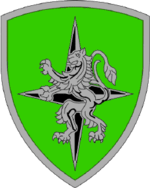Allied Force Command Heidelberg
| Allied Force Command Heidelberg | |
|---|---|
|
Central Army Group (CENTAG) Badge | |
| Active |
CENTAG: 1952-1993 LANDCENT: 1993-2000 JHQ CENT: 2000-2004 CC-Land HQ Heidelberg: 2004-2010 HQ FC Heidelberg: 2010-2013 |
| Allegiance |
|
| Part of | Joint Force Command Brunssum, Brunssum, the Netherlands |
| Headquarters | Campbell Barracks, Germany |
| Engagements |
IFOR SFOR KFOR ISAF |
Allied Force Command Heidelberg (HQ FC HD) was a unit with the NATO Military Command Structure responsible for providing Deployable Joint Staff Elements (DJSE) in support of NATO operations world-wide. HQ FC HB was garrisoned at Campbell Barracks, Germany and reported to Joint Force Command Brunssum, the Netherlands. HQ FC HB provided command and control elements for the International Security Assistance Force, Afghanistan.[1] It was closed down in a ceremony on 14 March 2013.
History
The Central Army Group (CENTAG) was established in 1952 and assigned to work with United States Army Europe at Campbell Barracks, Heidelberg, Germany. When the Bundeswehr was activated in 1955, some German personnel were assigned to the plans section of CENTAG.[2]
In April 1959, the plans section of CENTAG became Headquarters, Central Army Group and was commanded by an American general. It remained at Campbell Barracks and was charged with defending southern Germany against any prospective Soviet attack. It consisted of the German II Corps, the German III Corps, the US V Corps, and the US VII Corps.
In August 1961, CENTAG was relocated to Hammonds Barracks, (formerly Loretto Kaserne) Mannheim-Seckenheim, Germany and remained there until December 1980 when NATO determined coordination was better when three headquarters were located on the same installation. CENTAG was returned to Campbell Barracks to be collocated with the Fourth Allied Tactical Air Force (4 ATAF) and the Allied Command Europe Mobile Force-Land (AMF(L)).
Structural changes began in June 1993, when CENTAG and the Northern Army Group (NORTHAG), Mönchengladbach, Germany were deactivated and combined to form Allied Land Forces Central Europe (LANDCENT), which was activated in Heidelberg on 1 July 1993.[3]
LANDCENT's mission was to:[4]
- 1) contribute to the protection of peace and deterrence of aggression,
- 2) plan, prepare and direct operations of allocated land forces for the security and defence of his area of responsibility,
- 3) plan, coordinate, and conduct synchronized air/land operations in support of CINCENT's theater campaign, and
- 4) be prepared to conduct peace support operations
At the lower level, all strictly national corps in the central region were superseded, in wartime plans terms at least, by the mid 1990s. All NATO corps, except for the German IV Corps, were then multinational. In the mid-late 1990s there were four multinational main defence corps in NATO's Central Region: one Danish-German (LANDJUT), one Dutch-German (I. GE/NL Corps) and two German-United States (II GE/US and V US/GE). The two German-United States corps were strictly wartime command organisations.[5]
Originally, LANDCENT command was to be rotated between German and Dutch generals. In 1996, The commander of US Army Europe (USAREUR) assumed an additional role as commander of LANDCENT with General William W. Crouch assuming command. The dual command of USAREUR and LANDCENT allowed the continued integration of American forces into NATO's post-Cold War structure. In addition, an agreement was made which set out the arrangements under which the European Corps (Eurocorps), consisting of units from Belgium, France, Germany, Luxembourg, and Spain, would be made available to NATO in times of crisis.
Beginning in 1993, LANDCENT provided troops in the Former Republic of Yugoslavia. In 1995, LANDCENT provided troops for the Implementation Force (IFOR) and later served as the headquarters of the Stabilization Force (SFOR) in Bosnia-Herzegovina. When NATO acted in Kosovo in 1999, LANDCENT began operations in Pristina, Kosovo and Skopje, Republic of Macedonia and would serve as the headquarters for the Kosovo Force (KFOR).[6]
Reorganisation
The departure from the Cold War era brought the implementation of a new NATO Integrated Military Structure and LANDCENT was formally designated as Joint Headquarters Centre (JHQ CENT) in a ceremony held in March 2000. The new structure, which accompanied this designation, included personnel from five additional nations: the Czech Republic, Hungary, Italy, Norway and Poland - making a total of 12 NATO Nations contributing to the Headquarters. In July 2004, JHQ CENT was once again reorganised and designated as Component Command-Land Headquarters, Heidelberg (CC-Land HQ HB).
In 2006, NATO recognised the need for a more flexible command and control structure. To augment the current operational level commands, NATO experimented with the use of Deployable Joint Staff Elements (DJSE). The DJSE allow Allied Joint Force Command Brunssum, Allied Joint Force Command Naples, and Allied Joint Force Command Lisbon to command multiple operations from their home headquarters. CC-Land HQ HB was chosen to test the concept, and was designated Force Command Heidelberg (HQ FC HB) in 2010.[2] The first operation in which the DJSE played a role was commanding the International Security Assistance Force (ISAF), Afghanistan.[7]
Headquarters Allied Force Command Heidelberg has been deactivated as part of NATO's transformation. The newly activated Allied Land Command (LANDCOM), located in Izmir, Turkey, has assumed responsibilities from Allied Force Command Heidelberg in Germany as well as Allied Force Command Madrid in Spain.[8][9] The deactivation was finally completed on March 14, 2013.[10]
See also
Notes
- ↑ "ISAF". NATO.
- ↑ 2.0 2.1 "History of the Headquarters".
- ↑ Thomas-Durrel Young, 1997, p.8
- ↑ Thomas-Durrell Young, 1997, p.9, citing Briefing slides, 'Allied Land Forces Central Europe,' HQ LANDCENT, Heidelberg, n.d.
- ↑ Thomas-Durrell Young, 1997, p.18
- ↑ "History: Balkans". NATO.
- ↑ "ISAF 2010-2012".
- ↑ "NATO activates Allied Land Command in Turkey".
- ↑ "NATO Allied Land Command activating next week in Turkey".
- ↑ "Deactivation of Command Component Land Heidelberg".
References
- Thomas-Durrell Young, 'Multinational Land Forces and NATO: Reforming Processes and Structures,' Strategic Studies Institute, Carlisle Barracks, 1997
- Globalsecurity.org, Cold War NATO Army Groups, accessed 20 June 2010
